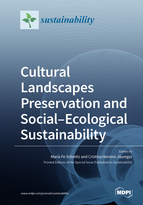Cultural Landscapes Preservation and Social–Ecological Sustainability
A special issue of Sustainability (ISSN 2071-1050). This special issue belongs to the section "Sustainability in Geographic Science".
Deadline for manuscript submissions: closed (30 June 2020) | Viewed by 63962
Special Issue Editors
Interests: cultural landscape; social–ecological systems; landscape heritage; biocultural diversity; protected areas; nature-based tourism; landscape structure
Special Issues, Collections and Topics in MDPI journals
Interests: social-ecological systems; landscape metrics; land use changes; cultural landscapes; rural development; urban ecology
Special Issues, Collections and Topics in MDPI journals
Special Issue Information
Dear Colleagues,
Cultural landscapes are the result of social-ecological processes that have co-evolved throughout history, shaping high-value sustainable systems. The current processes of global change, such as agricultural intensification, rural abandonment, urban sprawl, and socio-economic dynamics, are threatening cultural landscapes worldwide. Whereas this loss is often unstoppable because of rapid and irreversible social-ecological changes, there are also examples where rationale protection measures can preserve cultural landscapes while promoting the sustainability of social-ecological systems. However, not all conservation policymaking processes consider the value of cultural landscapes, which makes their preservation even more difficult. Indeed, conservation policies focused on the wilderness paradigm are often counterproductive to conserve highly valuable cultural landscapes.
The Journal of Sustainability is hosting a Special Issue entitled “Cultural Landscapes Preservation and Social-Ecological Sustainability”. Studies are welcome that formulate innovative theoretical and methodological approaches that are focused on management strategies for preserving cultural landscapes and natural heritage. Contributions on the following themes are of particular interest, although other relevant topics will also be considered:
- Models of cultural landscapes transitions—change trajectories of social metabolism and land use;
- Sustainability of social-ecological and cultural tourism-based systems;
- Social-ecological approach for the establishment and management of protected areas to preserve cultural landscapes;
- Development of tools based on social-ecological interactions for land planning, protection, management, and decision-making of cultural landscapes;
- Perception and valuation of cultural landscapes;
- Ethics of preservation and conservation paradigms;
- Resilience of cultural landscapes—tipping points and social-ecological sustainability;
- Ecosystems services provided by cultural landscapes.
Dr. María Fe Schmitz
Dr. Cristina Herrero de Jáuregui
Guest Editors
Manuscript Submission Information
Manuscripts should be submitted online at www.mdpi.com by registering and logging in to this website. Once you are registered, click here to go to the submission form. Manuscripts can be submitted until the deadline. All submissions that pass pre-check are peer-reviewed. Accepted papers will be published continuously in the journal (as soon as accepted) and will be listed together on the special issue website. Research articles, review articles as well as short communications are invited. For planned papers, a title and short abstract (about 100 words) can be sent to the Editorial Office for announcement on this website.
Submitted manuscripts should not have been published previously, nor be under consideration for publication elsewhere (except conference proceedings papers). All manuscripts are thoroughly refereed through a single-blind peer-review process. A guide for authors and other relevant information for submission of manuscripts is available on the Instructions for Authors page. Sustainability is an international peer-reviewed open access semimonthly journal published by MDPI.
Please visit the Instructions for Authors page before submitting a manuscript. The Article Processing Charge (APC) for publication in this open access journal is 2400 CHF (Swiss Francs). Submitted papers should be well formatted and use good English. Authors may use MDPI's English editing service prior to publication or during author revisions.
Keywords
- Multifunctional landscapes
- Natural and cultural heritage
- Management of protected areas
- Preservation of nature
- Naturalness and culturalness
- Sustainable tourism
- Social-ecological resilience
- Land-use change
- Land intensification
- Rural abandonment







